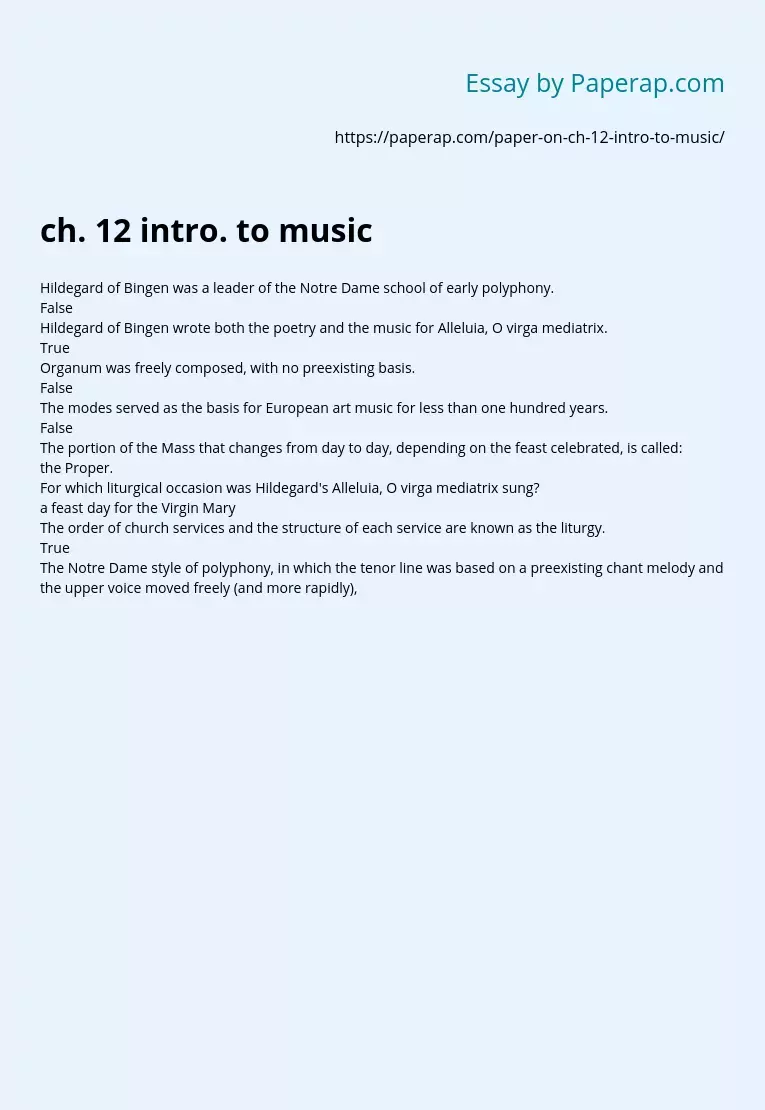ch. 12 intro. to music
Essay,
Pages 2 (474 words)
Views
140
Hildegard of Bingen was a leader of the Notre Dame school of early polyphony.
False
Hildegard of Bingen wrote both the poetry and the music for Alleluia, O virga mediatrix.
True
Organum was freely composed, with no preexisting basis.
False
The modes served as the basis for European art music for less than one hundred years.
False
The portion of the Mass that changes from day to day, depending on the feast celebrated, is called:
the Proper.
For which liturgical occasion was Hildegard’s Alleluia, O virga mediatrix sung?
a feast day for the Virgin Mary
The order of church services and the structure of each service are known as the liturgy.
True
The Notre Dame style of polyphony, in which the tenor line was based on a preexisting chant melody and the upper voice moved freely (and more rapidly), was called:
organum
An early center for the development of polyphony was the Cathedral of Notre Dame in Paris.
True
__________ is traditionally associated with collecting and organizing the chants of the church.
Pope Gregory
Early notation suggested melodic contours using small ascending and descending signs called:
neumes
The form of Alleluia, O virga mediatrix is A-A-B.
False
The portion of the Mass that remains the same in every celebration of the service is called:
the Ordinary.
The early polyphonic genre that resulted from the addition of texts to all voices was called:
the motet.
The earliest type of polyphony was:
organum.
In the early Middle Ages, music was often written in fixed patterns of long and short notes known as rhythmic modes.
True
Polyphony required the development of:
rhythmic modes.
The motet differs from organum with its emphasis on triads.
False
Which religious figure is praised in the text of Hildegard’s Alleluia, O virga mediatrix?
the Virgin Mary
A setting of Gregorian chant with two to four notes per syllable might be considered:
neumatic.
In what part of the liturgy does the Alleluia occur?
Mass Proper
Of the following, which does NOT describe life in the medieval cloister?
being at the center of trade and commerce
Hildegard’s Alleluia, O virga mediatrix has a neumatic text setting with some melismas.
True
A setting of Gregorian chant with one note per syllable is called:
syllabic
A setting of plainchant with many notes per syllable is called syllabic.
False
The service in the Roman Catholic Church that symbolically reenacts the sacrifice of Christ is:
the Mass.
Which of the following does NOT characterize Gregorian chant?
triadic harmonies
Why does Gregorian chant sound so different from other types of Western music?
There is no harmony.
In addition to composing music, Hildegard of Bingen is known for:
all of the above
What is the primary language of the Mass?
Latin
Of the following, which woman was a religious leader and a prominent figure in literature and music?
Hildegard of Bingen
ch. 12 intro. to music. (2017, Dec 18). Retrieved from https://paperap.com/paper-on-ch-12-intro-to-music/

